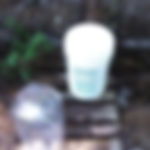Homemade Wilderness Brew
- saws44
- Oct 29, 2014
- 2 min read

In celebration of the 50th Anniversary of the Wilderness Act, I decided to make a beer with as many ingredients as possible gathered from Wilderness in Virginia. My first idea was to make a blueberry mint saison, but ended up making a blueberry sour beer. In this entry, I'll share photos, procedures and the recipe of this beer.
The ingredients of the beer that I collected from Wilderness were: water from Rich Hole Wilderness; blueberries from Rich Hole Wilderness; and yeast from James River Face Wilderness. The collection of the first two ingredients listed are straight forward; the yeast is less obvious.

To collect wild yeast, I created a sugar solution (basically unfermented beer), covered it with cheesecloth, and hung it from a tree branch like a bear hang. This was the first time I had intentionally fermented a beer with wild yeast. After 24 hours I collected the yeast and was pretty skeptical. There was a singular ant floating in the mixture that had magically traveled through the muslin bag barrier secured on top of the jar. The solution then fermented over the course of the next week.

When the initial yeast collection beer was fermenting, its smell was described as "old cafeteria," "soaking beans," and "vomit" by three different people. After that initial collection was done fermenting, there was the desired bacterial colony developing on the surface. The questionable scents, not to mention the mysterious ant, gave me the occasional doubt before the Wild beer was even made. However, I learned to appreciate the nature of wild yeast because this beer had an innate sense of place. It got its flavor profile from the native yeast attached to particulates in the air and to the insects on the ground in James River Face Wilderness.

Before beer was being mass produced, places had their own unique beers. Examples include the Düsseldorf Alt, the Munich Helles, Pilsner (from Plzen, Chech Republic). But much of that sense of place has been lost, the availability of yeast strains and the ability of the brewer to have complete control over fermentation has globalized beer, so now a brewery in rural Appalachia can make Pilsners and Dortmunder Exports. However, the Wild beer is an indigenous beer. It is Wilderness beer and it hails from the hinterlands of Virginia.

Here is the recipe:
Wilderness Saison/Sour (All Grain)
Batch size: 6 gallons
Mash temperature: 146o F
Mash thickness: 2 qt/pound
Original Gravity: 1.059
IBU: 21
Grain Bill:
10.5 lb Pilsner Malt
1 lb White Wheat
0.5 lb Vienna Malt
Hop Bill:
1.5 oz Saaz (3% AA) 90 min addition
1 oz Spalt (3.2% AA) 15 min addition
0.5 oz Saaz (3% AA) 5 min addition
Yeast:
White Labs Yeast 535 (3 gal)
Wild Yeast (3 gal)
Fermentation information: 68o F fermentation temperature, added 250 g crushed wild blueberries into each vessel at high krausen. 6.2% ABV for beer fermented with commercial yeast, 5.7% for wild yeast.
Beer notes: Both wild and cultured beers are slightly tart, probably from blueberries. Wild beer is slightly cidery and dry, despite its higher final gravity. Foam dissipates quickly, consider adding crystal malt at 5% of grist.
Happy 50th anniversary, Wilderness Act!